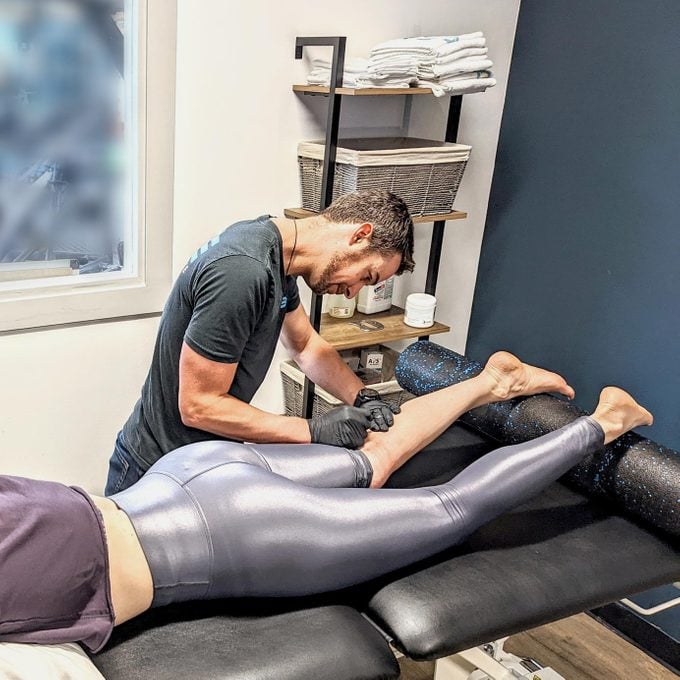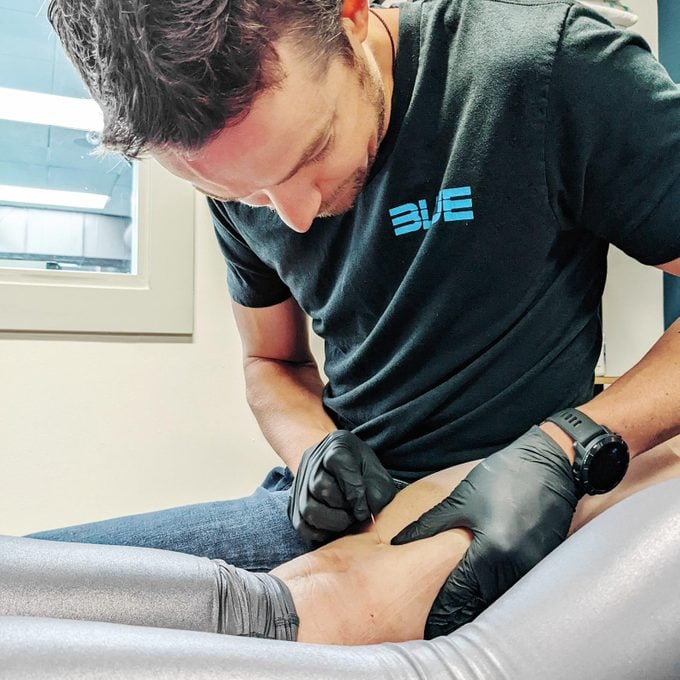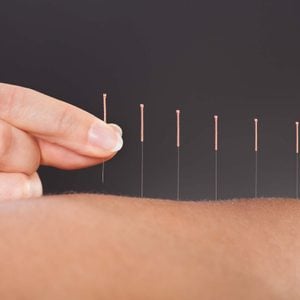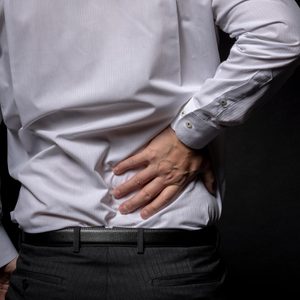Does Dry Needling Work? 2 Doctors Share This Treatment’s Potential to Heal and Reduce Pain
Updated: Jun. 08, 2022

Plus: photos of a real-life dry needling session from a physical therapist specializing in this intriguing pain management treatment with very cool science supporting its effectiveness.
Breaks, sprains, strains, and bruises are just part of the game for competitive gymnasts—but in 2002, a bad fall off the high bar landed Aaron Knighton in the hospital with a potentially life-altering injury: a broken spine. During the eight weeks he spent in a brace, the then-high school sophomore worried about more than just his gymnastics career. What would the rest of his life look like with chronic back pain?
Over 80 percent of U.S. adults report having back pain at some point—in fact, the Centers for Disease Control and Prevention has noted that chronic back pain is one of the top three causes of long-term disability in America. Part of the problem is that there aren’t many effective treatments, so someone affected with this can suffer for years with pain.
With such a strong personal connection to the science of recovery and pain management, Knighton pursued a doctorate degree in physical therapy. As part of his post-graduate training, he agreed to participate in a trial of a new physical therapy technique called “dry needling,” wherein a doctor inserted several needles into Knighton’s back, attached them to a battery, then used the electrical current to stimulate his atrophied back muscles.
His experience? “It was as close to a medical miracle as you can get,” Dr. Knighton tells The Healthy @Reader’s Digest today. “After almost two decades, the chronic pain was just gone and my strength and mobility came back, almost immediately. Not only did I feel better, but I discovered a powerful tool to better serve my patients. It changed my life.”
Dr. Knighton is now a doctor of physical therapy in Boulder, CO, who specializes in dry needling treatment.
What is dry needling?
“Dry needling consists of thin monofilament needles that are inserted directly into the tissue and manipulated to make the muscle relax for pain relief,” as Matt Briggs, PT, PhD, explains to The Healthy. Briggs is a physical therapist, researcher, clinical professor, and director of the Sports Physical Therapy Residency for Sports Medicine at Ohio State Wexner University.
He adds that the technique is used to treat dysfunctions in skeletal muscle and connective tissue to help diminish pain and reduce or restore impairments of body structure and function.
(Everything you need to know about trigger-point injections.)
What happens in a dry needling treatment…and does it hurt?

In a typical dry needling session, the clinician identifies which areas need treatment, sterilizes the skin with alcohol, and then preps the needles.
Dry needling uses a “clean needle” technique, where the needles are individually packaged in sterile pouches and are not reused. Similar to the concept of acupuncture, the needles are the therapy—they’re not used to inject anything. Most procedures are done without anesthetic. Sound a little daunting? Actually, due to the small size of the needles, Dr. Knighton reveals that most patients don’t even feel them being inserted.
That doesn’t mean it is a painless procedure, however. The clinician applies the needle directly into “trigger points”—and because they are already tender and inflamed, that can hurt.
Trigger points are “knots” or spots of tight muscle fibers that can form after injuries or overuse. They are a normal part of the body’s protective mechanisms, but they can lead to injuries. Using various techniques with the needles, the clinician can manipulate the trigger points to loosen and return the muscle to full function, says Dr. Briggs.
This leads to the super interesting science behind this procedure: “Dry needling is essentially hitting a big red reset button on your muscles and your nervous system in that area,” says Dr. Knighton, adding that dry needling increases muscle oxygenation, reduces inflammation, and over time improves neuroplasticity—the way the brain communicates with the nerves and muscles.
“The theory is that dry needling changes the way nerves and muscles function, and may even change the way our spinal cord and brain perceives pain,” says Dr. Briggs, who is currently conducting research on how dry needling affects knee pain.
Benefits of dry needling
Other athletes tout the power of this technique, including Olympic gymnast Aly Raisman, who, according to Bustle, has said dry needling helped her win her six Olympic medals by aiding her recovery from injuries and improving her muscular endurance.
Raisman’s experience sums up the four main reasons people use dry needling, according to Dr. Briggs and Dr. Knighton:
Pain relief
Reducing or relieving muscular or joint pain is the most common reason patients seek out this technique. Dry needling helps heal the source of the pain and improves the way the brain and muscles communicate. That reduces the perception of both acute and chronic pain.
Improved function
As we age, it’s common for many of us to lose range of motion and flexibility in certain parts of the body. Dry needling can help restore mobility and function by increasing the extensibility of the muscles in those areas.
Injury and surgery recovery
When you suffer an injury like a fracture or a sprain, or have surgery, your muscles automatically contract around the area to support and protect it. But those muscles can remain tight and painful even after the initial injury has healed. Dry needling can help “reset” those muscles.
Performance enhancement
Athletes improve by overloading their muscles, which can cause trigger points. If left untreated, they can reduce muscle power, range, and function and increase risk of injury. Dry needling releases tight knots and allows athletes to perform at a higher level.
Does dry needling work?

“While some people may see benefits immediately, it takes most people three to four treatments to start seeing results,” says Dr. Knighton. “In addition, dry needling should always be used as part of a larger physical therapy plan, including targeted exercises, joint mobilization, and other interventions.”
That’s made the technique relatively difficult to study in isolation, as there are many different methods—but there is some promising research. According to a 2021 meta-analysis of 42 studies published in the peer-reviewed medical journal, Physical Therapy, dry needling had a “large effect” in decreasing musculoskeletal pain within 72 hours after treatment. The researchers also found that the effect continued four to 12 weeks later.
Further, as another 2021 study published in Acupuncture in Medicine concluded, just one session of dry needling improved sensorimotor function, hypertonia (very tight muscles), and overall quality of life for people with chronic stroke.
There is strong evidence that dry needling can decrease muscle spasms and increase range of motion, leading to better daily functioning, according to a 2020 review, published in the American Journal of Occupational Therapy.
A 2017 meta-analysis of 13 studies, published in The Journal of Orthopedic and Sports Physical Therapy, found that dry needling improved function and range of motion when compared to a control group that used “sham” needles as a control for comparison.
What if you’re afraid of needles?
Dr. Briggs says perhaps the most common reason people avoid trying dry needling is a deep fear of needles. Turns out it’s not rare—one in four adults report having “needle phobia,” according to the CDC.
“If you’re nervous about any part of it, we need to know—so be honest about your fears with your doctor. This isn’t the time to just ‘gut through it,’” suggests Dr. Knighton. And, he says, “Ask lots of questions! Sometimes knowledge is the best remedy for fear. For instance, the needles are very, very thin—most people imagine something much bigger.”
Here are some tips you and your dry needling professional can do to make the experience less intimidating:
- Ask to see or touch the equipment (keeping in mind the importance of sterility)
- Position yourself comfortably with pillows
- Bring a support person or comfort object
- Cover your eyes with a cool towel
- Practice deep breathing techniques
- Scream into a pillow
- Swear (yes, it’s really fine, says Dr. Knighton—and cursing can help with pain relief)
Side effects of dry needling
During treatment you may feel a deep pressure and pain. Some patients may feel dizzy, faint, or shaky. The most common side effects afterward are redness, bruising, and mild swelling at the point of the needle stick. You will likely feel a deep ache in the muscle and sore for a day or two. If you have any signs of infection, like a fever or rash, call your doctor immediately.
Who should avoid dry needling
This technique should not be used to treat chronic illnesses, like heart disease or diabetes. Talk to your doctor first if you are on blood-thinning medications or if you have a blood-clotting disorder or blood-borne disease.
Note: The American Physical Therapy Association says dry needling is regulated on a state by state basis, and is not available everywhere.
Get The Healthy @Reader’s Digest newsletter for healthy insights delivered each day. Follow us on Facebook and Instagram, and keep reading:
- Here’s Why You Get Headaches from Exercise—with 3 Doctors’ Tips for Relief
- Here’s How Long the Best Nap Lasts, a Neuroscientist Says
- Over 40? 4 Gentle Mobility Exercises a Trainer Says You Should Be Doing
- The 10 Best Health Books of 2022: Therapists and Readers Rate the Bestselling Wellness Books So Far This Year
- The 13 Best Walking Shoes, from Podiatrists
















